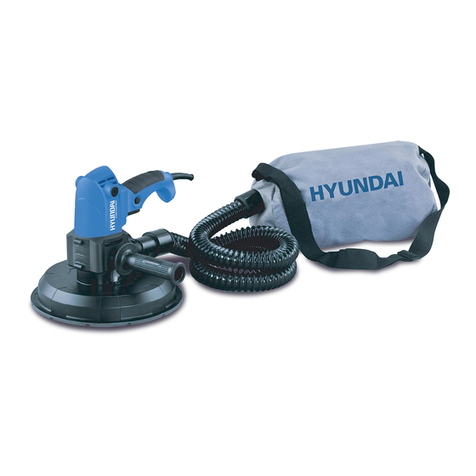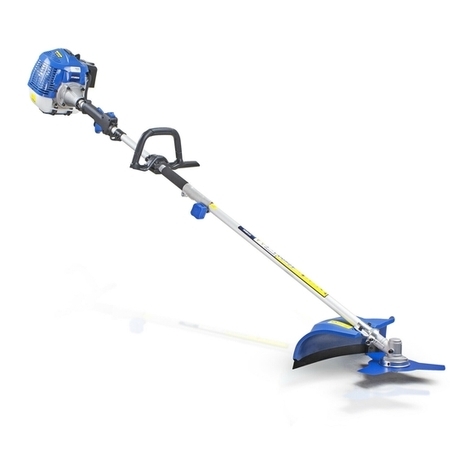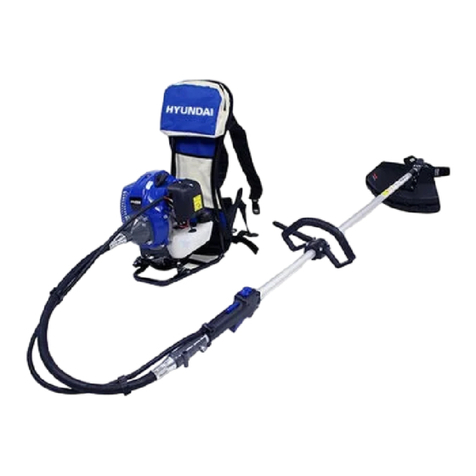
for long periods of time or not properly managed and properly maintained.
- There is risk of injury and property damage due to attachments or broken the sudden impact of hidden
objects.
- Risk of injury to persons and property caused by flying objects.
- Prolonged use of this product exposes the operator to vibration and can produce so-called “white finger”
disease. To reduce the risk, wear gloves and keep your hands warm. If any of the symptoms of “white
finger syndrome” occur, seek immediate medical attention. Symptoms of the “white finger” include
numbness, loss of sensitivity, tingling, tingling, and pain, loss of strength, color changes or skin
condition. These symptoms usually appear on the fingers, hands or wrists. Risk increases at low
temperatures
- Inhalation of particles
- Inhalation of exhaust gases
- Unattended projections
- Contact with foreign objects
- Contact with the tool in operation
- Hearing loss in the absence of correct hearing protection
2.3 SAFETY WARNINGS FOR THE MOUNTED POLE PRUNER
-Respect the capacity of the tool. Use the tool as described in this manual and for its intended use,
safely and safely.
-Do not use the tool if the switch is defective. In the event of a malfunction, do not use the tool and take
it to a qualified service for repairs.
-Stop the tool before making adjustments, changing the accessories or storing the tool.
-Keep the tool out of the reach of children. People who are not familiar with the tool or who have not
read these instructions should not use it. Tools are dangerous when used by untrained people.
-The tool must be regularly maintained. Regular tool maintenance reduces malfunctions and improves
work efficiency.
-Check that the moving parts are working properly and that they are not jammed. Check that there are
no broken or damaged parts that could impair the functioning of the tool. If the tool is damaged or faulty,
do not use the tool anymore and bring it to a qualified service for repairs.
-Keep cutting tools sharp and clean. Carefully maintained tools with sharp, sharp edges are wedged less
frequently and can be guided more easily.
-Never touch any part of the body of the cutting chain when the tool is operating. Before starting the tool,
make sure that the cutting chain is not in contact with anything. A moment of inattention while using the
tool may cause your garment or part of the body to stick to the cutting chain.
-Wear safety glasses and hearing protection. Additional protective equipment is recommended such as
helmets, protective gloves and safety shoes.
-Do not place yourself on the path of falling branches.
-Before felling, check where the trees or branches are going to fall. Make sure that there are no
obstacles to prevent or hinder travel.
-Do not work in areas where the grass is wet and where the soil is slippery.
-Do not use this tool in a tree, on an unstable ladder or surface.
-Adopt a stable position and keep your balance constantly.
-Hold the tool firmly with both hands when the engine is running.
-When the chain is moving, it must not touch objects, materials or persons.
-Start cutting only with a chain at full speed.
-Do not attempt to insert the saw into a pre-existing notch. Always make a new notch.
-Pay attention to moving branches or other forces that could close a notch and pinch or hinder the chain.
-Do not attempt to cut a branch with a diameter greater than the cutting length of the chain saw.
-Always switch off the tool, let the chain completely stop before making any adjustments, maintenance,
cleaning or repairs.
-When transport and storage, always stop the tool first and put the protection on the tool.
-The chain must remain sharp and taut. Regularly check the tension of the chain.
-Only use replacement parts and original accessories.
-Use only the manufacturers specified replacement guides and chains. Incorrect replacement guides
and chains may cause chain breakage and / or rebound.
-Check that there are no obstacles or electrical wires hidden in the work area.
-Immediately stop the device if an abnormal level of vibration has been detected. In case of damage to
the blade, it is necessary to change the complete set of blades.
-Use the device only if all protective devices are mounted. Do not use the device with faulty protective
09






































